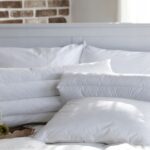Waking up with a stiff back might not always mean your mattress is the problem—it could be the lack of support or softness that’s causing it. That’s where a mattress topper comes in, especially a soft one designed to add comfort without replacing your entire bed. But choosing the right soft topper isn’t just about picking the fluffiest option. It depends on the material, your sleeping position, and how much support you actually need.
In this blog, we’ll help you understand what makes a topper the right match for your bed and your body.
Understanding Soft Mattress Topper Materials
Before you pick a soft mattress topper, it’s worth understanding the materials that give them their feel. This isn’t like choosing a mattress protector, which is mostly about shielding the bed—toppers directly change how your bed feels. Each material adds a different kind of comfort and support, so let’s break them down:
- Memory Foam
This material is known for molding to your body. It offers excellent pressure relief by cushioning pressure points like your hips, shoulders, and back. Many people find it helpful for reducing discomfort during the night. One thing to consider is heat retention—traditional memory foam can trap warmth. However, newer types often come with cooling features like gel infusions.
- Down and Down Alternatives
If you’re after that pillowy, cloud-like softness, down might catch your attention. It’s light, fluffy, and great for adding plush comfort. Down alternatives, usually made from polyester fibers, offer a similar feel and are often more allergy-friendly. But both tend to flatten over time and don’t provide much support.
- Natural Latex
Latex has a responsive, springy feel. It’s often made from rubber tree sap, which makes it a natural and durable choice. While it’s not quite as soft as down, it still offers gentle cushioning with better bounce and support. It’s also more breathable than memory foam.
- Wool
This material is ideal for those who want a cooler sleep experience. Wool toppers regulate temperature really well and wick away moisture. They’re soft but not overly sink-in plush, so you get comfort without feeling stuck. Plus, they naturally resist dust mites and odors.
Every material has its own strengths, and the right one depends on what kind of sleeper you are and what comfort means to you.
Matching Firmness and Softness to Sleep Position and Comfort Needs
A soft topper should feel cozy, but it shouldn’t throw your spine out of alignment. The trick is to match the softness with your sleep style. Everyone sleeps differently, and your body has specific pressure points based on how you lie down at night.
- Side Sleepers
You’ll likely want the softest option of all. That’s because your shoulders and hips press into the mattress more than any other part of your body. A soft topper gives those areas extra cushioning so you don’t wake up sore.
- Back Sleepers
You’re in the middle zone. Your back needs to stay supported, especially the lower spine. Look for a medium-soft topper that offers just enough give without sagging. Too soft, and your back might arch uncomfortably.
- Stomach Sleepers
A very soft topper usually isn’t the best pick here. Your hips might sink in too much, which can lead to lower back strain. A firmer soft topper or even a medium one, can provide the balance you need without throwing off your alignment.
Also, think about your body weight. A lighter person may find a plush topper supportive, while a heavier sleeper may compress the material more and need something with a bit more density, even in a “soft” range.
Pros and Cons: How Each Material Performs
Choosing a soft topper goes beyond comfort, it’s also about how well it holds up, how it affects your body, and how comfortable it stays during the night. Here’s how the materials compare on some key points:
Pressure Relief
- Great: Memory foam, latex
- Good: Wool
- Less effective: Down and alternatives
Breathability
- Excellent: Wool, latex
- Moderate: Down alternative
- Low: Traditional memory foam
Durability
- Long-lasting: Latex
- Moderate: Wool, memory foam
- Shorter lifespan: Down
Support
- High: Latex, memory foam
- Medium: Wool
- Low: Down
So if you want pressure relief and a long life, latex or memory foam might be your best bet. If you sleep hot, wool or latex can help regulate temperature. And if softness is your main goal, down feels incredibly plush—just know it won’t offer much support long-term.
Conclusion
The right soft mattress topper brings more than comfort—it shapes how well you rest every night. Choosing based on your sleep position, the material’s feel, and long-term performance helps you make a decision that actually benefits your sleep. Combined with a mattress protector, it can also keep your bed clean and feeling fresh for years.
As more people start paying attention to how their sleep setup affects their health, comfort upgrades like soft toppers are becoming essentials, not extras. You don’t need to overhaul your entire bed to get better sleep. Sometimes, all it takes is the right layer in the right place.
- How to Choose the Perfect Soft Mattress Topper That Suits Your Comfort
- This material is known for molding to your body. It offers excellent pressure relief by cushioning pressure points like your hips, shoulders, and back. Many people find it helpful for reducing discomfort during the night. One thing to consider is heat retention—traditional memory foam can trap warmth.
- mattress protector
Related posts:
 The Complete Guide to Selecting the Best Italian Marble to Install in Your Home or Office
The Complete Guide to Selecting the Best Italian Marble to Install in Your Home or Office
 Safe Ship Moving Services Discusses How to Pack Fragile Items for a Move
Safe Ship Moving Services Discusses How to Pack Fragile Items for a Move
 Trusted Roof Installation Experts in Brooklyn, NY – JC Master Inc
Trusted Roof Installation Experts in Brooklyn, NY – JC Master Inc
 Confidential & Convenient: Get an STD Test at Home with Doctor on Call in Dubai
Confidential & Convenient: Get an STD Test at Home with Doctor on Call in Dubai
 Key Steps in Kitchen Installation Poole | Complete Guide 2025
Key Steps in Kitchen Installation Poole | Complete Guide 2025
 “How to Plan a Successful, Stylish, and Budget-Friendly Interior Renovation”
“How to Plan a Successful, Stylish, and Budget-Friendly Interior Renovation”
 How to Plan a Successful Poultry Farm Construction Project Easily
How to Plan a Successful Poultry Farm Construction Project Easily
 Struggling with Flat Pillows? Discover the Lasting Fluff of Down Feather Options
Struggling with Flat Pillows? Discover the Lasting Fluff of Down Feather Options







